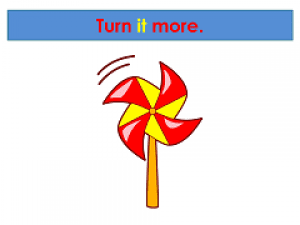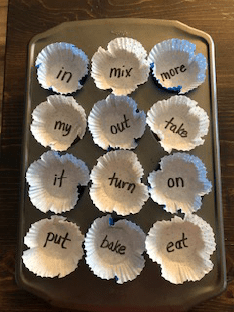
Go - Have your student use this word to direct you to let the top or fidget spinner go.
Stop - Model this word when the top or fidget spinner stops spinning.
Turn - Model and teach this word to comment on how the top or fidget spinner turns.
Fast/Slow - Teach these words to describe the speed in which the top or fidget spinner is moving.
My turn – Model and teach this phrase when it is “my turn” with the top or fidget spinner.
Help - Model and teach the student how to ask for help. If they get stuck during any activity, encourage them to use their device to ask for help.


Use the Turn It writing template with your student. Have them use target vocabulary words to fill in the blanks near each symbol. Read the word wtih the student and ask them to find it on their device. If their device supports computer emulation, they can use it as an alternative keyboard. If not, just fill in the words for them.
Connect the device to the computer using a USB cable or Bluetooth adaptor. Let the student use their device to write the target vocabulary. Be sure to make the font large. Print out the words for your student.
If you are using WordPower (Saltillo or TouchChat), save the person’s writing using Stories and Scripts within the vocabulary. Learn more about this feature here.

Make a button spinner - Thread two buttons onto a 2-foot length of string, then tie it into a loop. Holding each end of the loop, whirl the buttons around to wind them on the string. Pull your hands apart to spin the buttons, then let the string go slack so that they spin and rewind. Repeat the motion to get the buttons spinning faster. Have the student use his/her device to describe the activity. Did his/her button spin “fast” or “slow?" Did he/she “turn it” or “stop it?" Did it “go fast” or “go slow?" You can watch a video on how to make a button spinner on You Tube.
Make some flying fish - Cut a strip of paper. (My strip measured about 20cm x 2cm but there is no need for accuracy - hurray!) Cut slits at either end, as shown. Make lots….everyone will want to try. Bend the strip of paper and slot ends together. Throw in the air and watch them spin as they come down. After the activity, have the student use his/her device to talk about it. Did the fish “go fast” or “go slow?" Did the fish “turn?" When did they “stop?"
Watch Laurie Berkner’s video "Fast and Slow" on YouTube. Have the student use his/her device to tell if the animals are going “fast” or “slow.” The student can also use go, stop, turn, etc.
Can-Do Cards are fun, motivational activities the entire family can do to help your child improve their communication skills. Most activities will fit nicely into your daily family routines.
Start Homework Plan
NEXT SECTION
Two to Three Word Phrases
Select if you’re proficient at this objective and ready to move onto the next objective
Common Core Standards
Below are references to the Common Core Standards organized by grade level and associated with the goals and objectives of this lesson plan. When considering which standards to target in your lessons with students, begin by looking at the standards at your student’s grade level. You may need to refer to that same standard at a lower grade level to adapt your lesson to best meet the needs of your student.